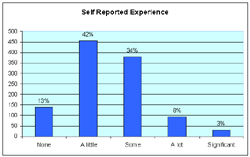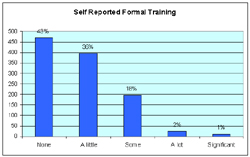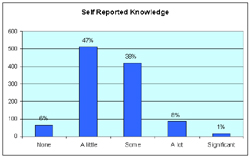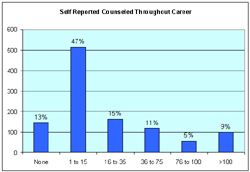Self-Reported Experience with Safe Transport of Children with Special Health Care Needs: A Rehabilitation Therapist Perspective
ABSTRACT
Minimal information is available to rehabilitation therapists regarding the safe transportation of children who have special health care needs (CSHCN). CSHCN may have conditions that impact their ability to be properly restrained in motor vehicles. A recent survey of caregivers of CSHCN revealed that 31% of respondents would prefer to get information regarding safe transport of CSHCN from occupational or physical therapists.(1) A free online training to provide rehabilitation therapists with basic knowledge of safe transport of CSHCN was developed by the Injury Prevention Center at Connecticut Children's Medical Center. Training participants were surveyed to determine the level of pre-existing knowledge, formal training and experiences with safe transport. The results indicate that prior to participation in the training rehabilitation therapists rated themselves as having little formal training, knowledge or experience in this area.
KEY WORDS :
Children with special health care needs, transportation
BACKGROUND
Despite numerous campaigns to promote the use of safety belts and child restraints, and despite child occupant protection laws in every state, motor vehicle crashes are the leading cause of death and injury for children over age one. Of children ages 0 to 12 years who were killed in motor vehicle crashes in 2000, nearly 20% were restrained improperly. Types of misuse of child safety seats and occupant restraints range from inappropriate restraint selection to improper installation and use. (2)
CSHCN may be less able to tolerate and utilize traditional occupant protection systems. Little training or public information is available to parents or health care providers on the resources and devices available to protect these children in motor vehicles. As with other assistive devices for CSHCN, occupational and physical therapists as well as seating specialists are in a position to provide guidance to families on safe methods for transporting their children.
With the field of occupant protection changing rapidly to adapt to greater methods of protection for motor vehicle occupants, rehabilitation therapists are ideally suited to become advocates for implementing safer transportation for CSHCN. (3) The online safe transport of CSHCN training was developed to address this need.
RESEARCH QUESTION
The objectives of this study were to determine the level of pre-training knowledge, formal training in safe transport for CSHCN, and experience in counseling families regarding safe transport for CSHCN among rehabilitation therapists enrolled in an online training program. The goal of the online training is to address the rehabilitation therapists level of knowledge with the anticipation of increasing the amount of counseling provided to families regarding safe transport of CSHCN. It is hoped that all of these outcomes will result in more CSHCN traveling safely in motor vehicles.
METHOD
Letters of invitation to participate in the free online training for safe transport of CSHCN were sent to 6,000 members of rehabilitation organizations. More than 1000 people completed the registration process. (Table 1) The registration included a survey of experience with safe transport.
The survey asked registrants to provide information on certifications, years of practice and professional organization affiliations. Additionally, they were asked to rate their formal training, experience and knowledge in the field of safe transportation of CSHCN as: none, a little, some, a lot or significant. Registrants were also surveyed regarding the number of patients/clients they have counseled regarding safe transportation during their entire career.
Organization |
Number of Letters Sent |
Number of Registrants |
|---|---|---|
Rehabilitation Engineering & Assistive Technology Society of North America (RESNA) |
1000 |
61 |
American Occupation Therapy Association (AOTA) |
1000 |
145 |
American Physical Therapy Association (APTA) |
4000 |
614 |
Other Affiliations |
N/A |
200 |
Total |
6000 |
1096 |
RESULTS
 |
|---|
Over half of respondents reported that they had “none” to “a little” experience with safe transport of children with special health care needs. Thirty-four percent had “some” experience and very few had “a lot” or “significant” experience (Graph 1). Forty-three percent of participants had never received formal training regarding safe transport (Graph 2) yet and forty-seven (47) percent rated themselves as having “a little” knowledge of the subject. (Graph 3)
 |
|---|
Fifty-two percent of participants have been in practice for over 10 years. Nearly half of the participants (47%) have only counseled families of CSHCN regarding safe transport one to fifteen times in their career. (Graph 4) Those therapists with more than ten years of practice and higher self-reported knowledge, training and experience, were more likely than those with less practice, knowledge, training and experience to counsel families regarding safe transport.
 |
|---|
DISCUSSION
The online training developers expected two hundred participants for the online course. The number of registrants (1096) has far exceeded this expectation and speaks to the demand for such knowledge and training.
The major findings of this survey are that rehabilitation therapists have had little formal training or experience in the area of safe transport of children with special health care needs. This led to a lack of knowledge in the area and resulted in little counseling on safe transport of CSHCN being provided to families. This is significant given that families of CSHCN have indicated a desire to receive this information from rehabilitation therapists.
 |
|---|
The survey shows an association between increased knowledge and training regarding safe transport and an increase in counseling of families. It is expected that upon successful completion all 1096 participants will have the training and knowledge required
to increase counseling of families regarding safe transport. In turn this should result in many more CSHCN being transported safely in motor vehicles.
REFERENCES
- Henzy-Blake, E. et al. “Safe transport for Children with Special Health Care Needs: A Study of Parental Experience” (paper presented at the annual meeting of the Rehabilitation Engineering and Assistive Technology Society of North America, Atlanta, GA, June 2003).
- National Center for Injury Prevention and Control, Center for Disease Control. Child Passenger Safety Fact Sheet. [Online] URL: http://www.cdc.gov/ncipc/factsheets/childpas.htm [November 27, 2002]
- Paley, K. et al. (1993). Transportation of Children with Special Seating Needs. Southern Medical Journal. 86(12): 1339-41
ACKNOWLEDGEMENTS
This study was supported in part by MC 00127 01 from the Department of Health and Human Services, Health Resources and Services Administration, Maternal and Child Health Bureau.
Author Contact Information:
Eileen Blake, MPH,
Connecticut Children's Medical Center,
282 Washington Street,
Hartford, CT 06106.
Office (860)545-9943
Email: ehenzy@ccmckids.org
